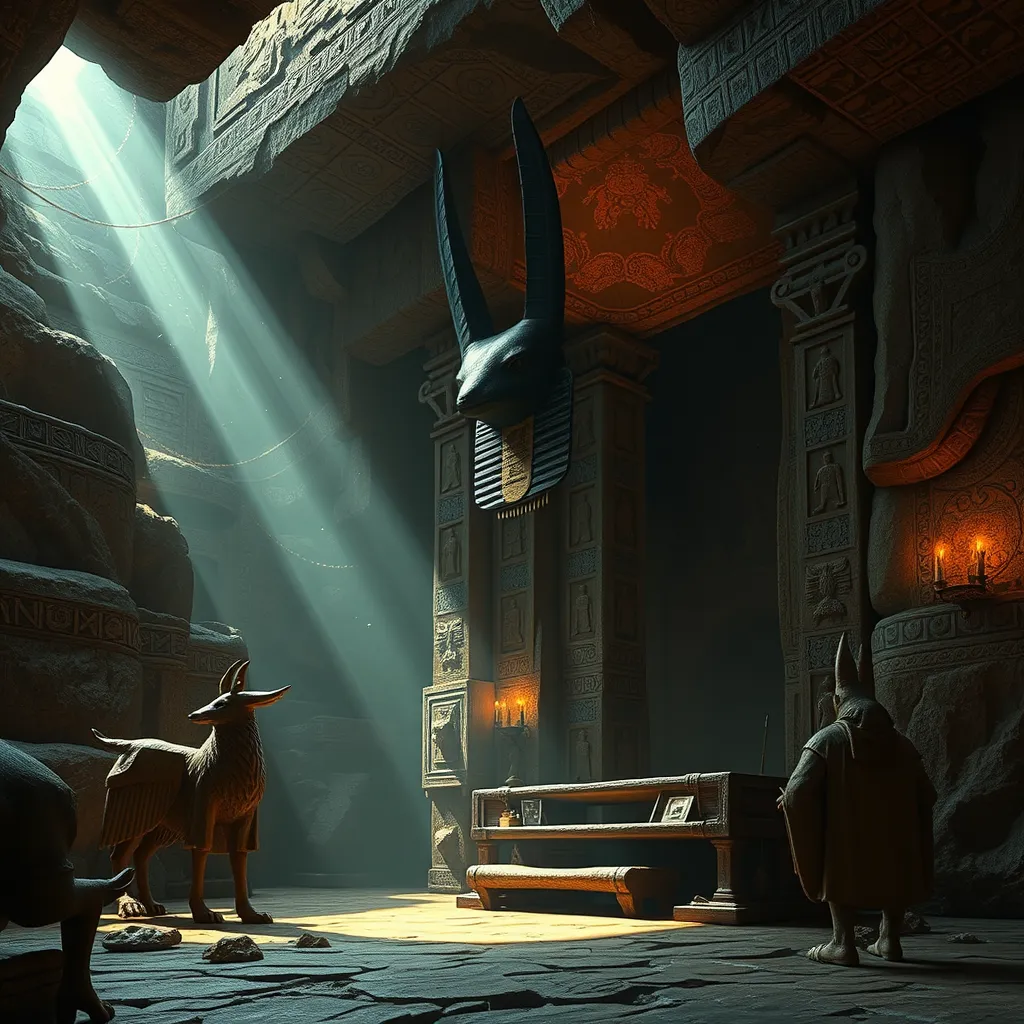The Duat: The Underworld Home of Anubis
I. Introduction to the Duat
The Duat, often referred to as the Egyptian underworld, holds a significant place in ancient Egyptian mythology. It is the realm where souls journey after death, a place of transformation and judgment. The Duat is not merely a dark abyss; it is a complex and intricate landscape filled with challenges and opportunities for the deceased.
At the helm of this mystical realm is Anubis, the jackal-headed god who serves as the deity of the afterlife. Anubis is crucial in guiding souls through their journey in the Duat, ensuring they are prepared for the afterlife and that their earthly remains are preserved for their spiritual journey.
II. The Mythological Framework of the Duat
The Duat is often depicted as a vast expanse filled with various landscapes, including rivers, fields, and mountains, each representing different aspects of the afterlife. Its geography can be described as follows:
- The River of Fire: A perilous body of water that souls must navigate.
- The Field of Reeds: A serene area representing paradise for the righteous souls.
- The Hall of Two Truths: The realm where souls are judged.
The structure of the Duat is divided into several realms, each with its unique challenges and guardians. These realms are interconnected, creating a labyrinthine journey for the deceased. The layout serves both as a physical representation of the journey and as a metaphor for the trials one faces in life and death.
III. The Role of Anubis in the Duat
Anubis plays a pivotal role in the Duat, acting as the guide for souls as they navigate the afterlife. His responsibilities can be categorized into two main areas:
- Guide for Souls: Anubis is often depicted leading souls through the Duat, helping them overcome obstacles and ensuring they reach their final destination.
- Embalming Process: Anubis is associated with mummification, overseeing the preservation of the body to ensure the soul can recognize it in the afterlife.
His presence is crucial as he not only prepares the deceased for their journey but also ensures that they are treated with respect and dignity in death.
IV. The Journey Through the Duat
The journey through the Duat is fraught with challenges and tribulations. Souls must navigate various trials to prove their worthiness. Some key aspects of this journey include:
- Obstacles and Guardians: Souls encounter numerous guardians and creatures, including serpents and demons, that test their resolve.
- Weighing of the Heart Ceremony: This crucial event determines the fate of the soul. The heart of the deceased is weighed against the feather of Ma’at, the goddess of truth and justice.
The outcome of this ceremony is monumental; a heart that is lighter than the feather signifies a pure soul, allowing entry into the afterlife, while a heavier heart indicates a life filled with wrongdoing, resulting in the soul being devoured by Ammit, a fearsome creature.
V. Symbolism and Iconography of the Duat
The Duat and Anubis are rich in symbolism, and various symbols are commonly associated with them:
- The Ankh: Symbolizing life and immortality.
- The Feather of Ma’at: Representing truth and justice.
- Jackal: Anubis’ animal form symbolizes protection and the guarding of graves.
Artistic representations in ancient Egyptian art frequently depict Anubis overseeing the mummification process or guiding souls through the Duat. These illustrations not only served a decorative purpose but also provided spiritual guidance for the living and the deceased.
VI. The Duat in Ancient Egyptian Beliefs
The cultural importance of the afterlife in Egyptian society cannot be overstated. The Duat was seen as a continuation of life, where the deceased could enjoy eternal bliss if they lived righteously. This belief influenced various aspects of Egyptian life, including:
- Burial Practices: Elaborate tombs and burial rites were designed to honor the dead and ensure safe passage through the Duat.
- Tomb Construction: Tombs were constructed with detailed inscriptions and offerings, often depicting scenes of the deceased in the Duat.
The emphasis on the afterlife led to the development of a rich tradition of funerary texts, such as the Book of the Dead, which contained spells and guidance for navigating the Duat.
VII. Modern Interpretations and References to the Duat
The Duat’s influence extends into contemporary literature and media, where it is often referenced in stories exploring themes of death, the afterlife, and spirituality. Some notable examples include:
- Literature: Modern novels often incorporate elements of the Duat in their narratives, exploring ancient themes in a contemporary context.
- Media: Movies and television shows sometimes depict Anubis and the Duat, bringing ancient mythology into popular culture.
In modern spirituality, the concepts of the Duat and Anubis are often viewed through a metaphorical lens, representing the journey of the soul and the quest for truth and balance in one’s life.
VIII. Conclusion
In summary, the Duat holds a significant place in ancient Egyptian culture, representing the complexities of life, death, and the afterlife. Anubis, as the guide and protector, symbolizes the importance of preparation and respect for the deceased, ensuring their safe passage into eternity.
The enduring legacy of Anubis and the Duat continues to captivate our imagination, reminding us of the rich tapestry of beliefs surrounding life after death and the eternal quest for truth and justice. The fascination with these ancient concepts persists, illustrating their relevance in both historical and modern contexts.




